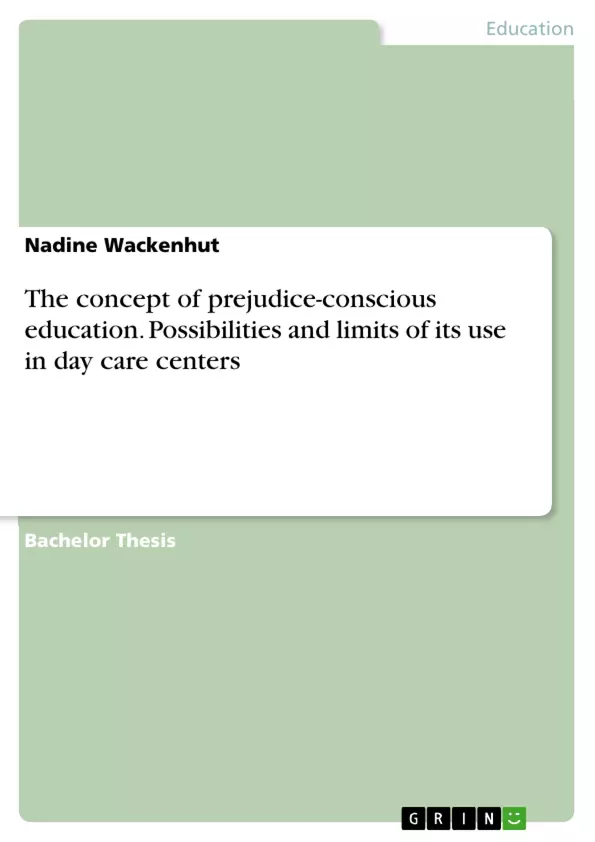This paper deals with the concept of prejudice-conscious education and the possibilities and limits of its use in day care centers. It examines the question of how children learn about prejudice and discrimination and what functions and consequences this has. Furthermore, the "anti-bias approach" is presented, which not only deals with how a good handling of stereotypes and prejudices can be acquired, but also stands for viewing diversity as enriching and valuable. The basic principles and methods of implementation provided for this purpose are the focus of the work and are examined in terms of their feasibility in early childhood education and care facilities. In addition to parental work and methods or strategies such as the "Persona Dolls", the work of the pedagogical staff as well as the design of the facility and the materials are the main focus. An additional component of this work is the presentation of the project "Kinderwelten" from Berlin, which represents a program adapted to Germany for prejudice-conscious education. It was also explained that the contents and topics of intercultural work must differ depending on culture and society, since each country is characterized by a different history.
Table of Contents
- Introduction
- Prejudices and stereotypes
- Definitions of terms
- Prejudices
- Stereotyping, demarcation from the concept of prejudice
- Development of prejudices and stereotypes
- Development of pre-prejudices
- Developing prejudice through direct experience
- Importance of society for the development of prejudice
- Other factors influencing the formation of prejudices
- Function of prejudices and stereotypes
- Problems and consequences of prejudices
- Prevention of prejudice
- Definitions of terms
- Discrimination and racism
- Disambiguations
- Levels of discrimination
- The anti-bias approach
- Emergence of the concept
- Objectives of the anti-bias approach
- Key elements of the approach
- Mission statement and basic assumptions
- The Children's Worlds project
- Content
- Adaptation and development project
- Dissemination project
- Project for the qualification of skilled workers
- Possibilities and limits of use
- Materials and design of the furnishings
- Pedagogical professionals
- Implementation of action strategies
- Working with Persona Dolls
- Cooperation with parents
- Conclusion
Objectives and Key Themes
This work aims to explore the development and adoption of prejudices and stereotypes in society, focusing on early childhood education and development. It examines the definition and distinction between prejudices and stereotypes, analyzing factors that contribute to their emergence. The work further investigates the impact of prejudices on early childhood education and development, emphasizing the need for a considered approach to address these issues.
- Defining and distinguishing between prejudices and stereotypes
- Examining the development of prejudices in infancy and through personal experiences
- Analyzing the influence of society on the formation and appropriation of prejudices
- Exploring the functions and dangers associated with prejudice formation
- Highlighting the importance of preventive measures for developing a prejudice-conscious attitude
Chapter Summaries
- Introduction: This chapter provides a starting point for the work, introducing the concept of prejudice and its complexity. It emphasizes the tenacity of prejudices and explores their impact on early childhood education and development.
- Prejudices and Stereotypes: This chapter delves into the definitions of "prejudice" and "stereotype," differentiating between the two concepts. It explores the development of pre-prejudices, how prejudices can form through direct experience, and the significant role of society in shaping prejudices. The chapter also examines the functions and consequences of prejudice formation.
- Discrimination and Racism: This chapter focuses on the definitions and explanations of "discrimination" and "racism," exploring the different levels of discrimination based on their intensity.
- The Anti-Bias Approach: This chapter introduces the anti-bias approach from California as a tool to actively combat discrimination in daycare centers. It examines the approach's origins, content, and goals, highlighting its focus on promoting respect and appreciation for diversity.
- The Children's Worlds Project: This chapter discusses the Children's Worlds project, a German initiative inspired by the anti-bias approach. It delves into the project's content, adaptation and development, dissemination, and qualification initiatives.
- Possibilities and Limits of Use: This chapter explores the opportunities and challenges associated with implementing prejudice-conscious education in daycare centers. It examines the role of materials, design, pedagogical professionals, action strategies, working with Persona Dolls, and parent cooperation in achieving this goal.
Keywords
This work explores key terms such as prejudices, stereotypes, discrimination, racism, anti-bias approach, early childhood education, and the Children's Worlds project. It emphasizes the importance of developing a prejudice-conscious attitude and understanding the impact of societal influences on prejudice formation.
- Quote paper
- Nadine Wackenhut (Author), The concept of prejudice-conscious education. Possibilities and limits of its use in day care centers, Munich, GRIN Verlag, https://www.grin.com/document/1235815



